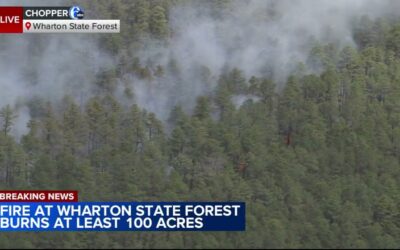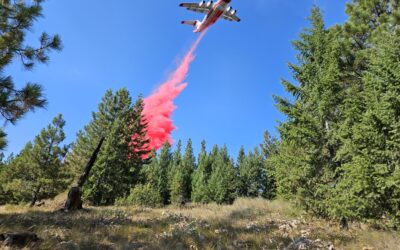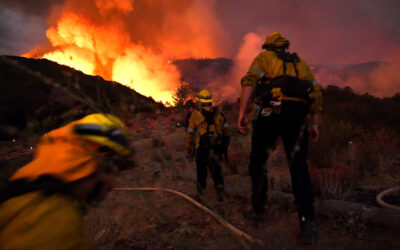Amy Bainbridge, Angus Whitley
Bloomberg News
(TNS)
More frequent fires. Smaller, cooler blazes. Nighttime and early morning burns.
Those are three important principles of what’s known as cultural burning, a firefighting practice honed by Indigenous people in Australia over the past 60,000 years. The techniques stand in marked contrast to the “hazard-reduction” burns employed in the U.S., Canada and other places prone to wildfires, including most of Australia. Indigenous advocates say their own methods are more effective, safer and kinder to native flora and fauna.
In the wake of Black Summer three years ago, Australian politicians said they’d prioritize Indigenous techniques. It’s since funded a range of grants and says it is continuing to make investments. But Indigenous organizations say far more is needed, especially now, with El Niño conditions bringing warmer temperatures that portend a more severe fire season.
Bloomberg Green spoke with two leaders of Australian organizations that promote and provide training in traditional burning methods, and a Canadian councilor who has welcomed Indigenous Australians to his province to help conduct cultural burns there. The conversation has been edited for length and clarity.
How is the Indigenous approach different to a typical hazard-reduction burn?
Victor Steffensen, co-founder and lead fire practitioner, Firesticks, a nonprofit that promote Indigenous techniques: Our burning application is all year-around, when we include the harvesting techniques and the preparation of country (land). Sometimes we burn the same place two or three times in one year. If there’s vegetation, like introduced grasses, that doesn’t belong in those systems, we’ve been walking through and burning them at different times than when we burn the native species. That allows us to protect the soils and the right types of vegetation.
Robbie Williams, the custodian of Fire Lore, which uses cultural burns: As it gets late in the afternoon, the winds will start to die right down. Then we’ll start coming in and doing all of our night burns so we can get more control of that fire and make it do exactly what we want. If you come into one of our burns, what we call cold burns, you can literally walk along with the fire, touch the soil. Green grasses are still there.
You won’t get our fires going past your knees — that’s how little our fires are. When we burn, it gets rid of the fuel loads. It helps the trees become healthier. When they get into a nice healthy state, bushfires can’t come there anymore.
You say your techniques have been well received by farmers in Australia, who have embraced cultural burning as a way to protect their properties. How universal are your techniques?
VS: Everywhere will be different, but what I’m finding in Canada and in America is pretty much the same principles as in Australia. We are working with two Indigenous communities in Canada. They had some knowledge, but basically we were starting from scratch and rebuilding that knowledge base, reading country, understanding soil types so that we’re able to apply a fire in a way that that only burns specific ecosystems. In the first trips when I went over we only burned very small patches. Now three years later we’re burning 500 hectares because our confidence has grown immensely.
How did those communities fare during Canada’s fire season this year?
VS: They didn’t get the brunt of the wildfires. But they are more or less protected this season if it does go their way as well. The communities are setting dates for next year and they want to continue the program. We also have some members of the community coming to Australia for one of our fire workshops here. So we’re looking at getting more exchange happening and we’re set to continue the mentorship program next year.
Anthony Billyboy, the wildfires haven’t reached your community this summer. Do you feel like you community is protected because of the cultural burning you’ve done there?
Anthony Billyboy, councillor, Yunesit’in Government: In a way, yes. I feel it’s protected because we’ve done a lot of work in the past years [on cultural burning techniques]. A fire of a mass size, you can’t tell what it’s going to do — you just stay back. You get out of there. Having been a firefighter, it’s safety first. So we don’t want to be close, you just stay out of there.
I think it will help in some way. Maybe it will just come creep up to what we did already and it’ll stop because it’s so green.
Our community in Stone, Yunesit’in, we’ve done a lot of burning. Last year we received an award for it, for the huge work we did up and down the community where we started from the bottom of the mountain where it creeped up to the snow caps. We had a good team, me and my wife and the brother-in-law, we just understand the land, so we put fire to the ground and we knew where it was going to make a difference and where it was going to stop.
What are the most important things you have learned about cultural burning?
AB: Probably the most important thing is we’re re-learning this. We’re re-introducing it to our people, where we work with youth and elders. And another thing is it’s bringing back our traditional medicines and fruit berries and it’s bringing back our wildlife. It used to be if you drove a few kilometers out you’d be lucky to see deer. Now we have one just right in the backyard.
You contend that modern hazard-reduction fires can actually make wildfires worse. Can you explain how?
RW: With hazard-reduction burns, they burn all the canopies of the trees, the leaf litter drops down and it builds up and gets worse every time they do it. It [creates] more fuel loads.
We do the burning the proper way by obeying fire lores — not burning the canopy, not cooking the soil and we allow everything to get away. That includes all the insects. It doesn’t build up fuel loads, it brings back the proper grasses. The trees don’t drop their leaf litter because we didn’t burn all the canopy.
Can you burn near towns and in rural areas? And is it scaleable?
VS: We’re burning around townships now. We’re burning right in the middle of a town in the Hunter Valley. The residents all came out and saw a beautiful fire, and we had a workshop to show them why it was so important.
Burning the Indigenous way in built-up areas is far safer than hazard-reduction burns. There’ll be smaller fires, there’ll be more frequent fires — not one time a year where they burn massive amounts of landscape. They’re burning the wrong system at the wrong time and creating big great plumes of smoke.
RW: We’ve been doing projects in agriculture. Farmers are happy to work with us because we’re saving them a lot of money, getting rid of the weeds without using poisons. It also brings back the proper grasses for their country, which helps feed their cattle.
What role is climate change playing?
VS: In Australia, climate change and global warming hasn’t affected our burning patterns — it might change our burning times. It’s the same with countries that are experiencing fires for the first time. It’s about being adaptable.
___
©2023 Bloomberg News. Visit at bloomberg.com. Distributed by Tribune Content Agency, LLC.




